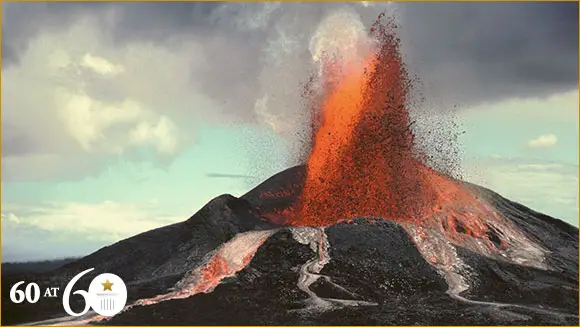
There are certainly better-known volcanoes than Kilauea. Vesuvius, for example, in Italy’s Gulf of Naples, has erupted since prehistoric times – the most infamous occasion coming in AD 79, when the cities of Pompeii and Herculaneum were swamped in lava flows, noxious gas and ash. (The term ‘magma’ is used to describe super-hot molten, or semi-molten rock in subterranean chambers; the material is referred to as ‘lava’ when it has reached the surface.) Or Krakatoa in Indonesia, which erupted in August 1883, killing nearly 40,000 people (many in the resulting tsunamis) and unleashing spumes of sulphur dioxide and other noxious gases 27 km (17 miles) into the atmosphere, lowering global temperatures for the following five years. The sound of its eruption measured 172 decibels at a distance of 160 km (100 miles), although it was audible thousands of miles away, and is credited as the Loudest sound ever heard. Both volcanoes – and many others the world over – remain active, and are still prone to sporadic eruptions. But Kilauea has the edge on both of them in one respect.
The islands of Hawaii are located above a highly active area of the Earth’s crust, a geothermal cooking pot out of which the islands themselves arose many millennia ago. Little wonder, then, that the volatile subterranean forces below have brought Hawaii a slew of related records, including the Largest active volcano (Mauna Loa) and the Longest lava cave (Kazumura Cave, stretching for 59.3 km, or 36.9 miles). That cave lies within the shield volcano Kilauea, the youngest and most southerly of the numerous volcanoes in the Hawaiian archipelago, and the Most active volcano in the world. Shield volcanoes are formed out of fluid streams of lava; consequently, they are low-lying, but taking up a large surface area.
Kilauea – the name means ‘spewing’ – rises some 1,227 m (4,190 ft) above sea level, and may first have erupted as long as 600,000 years ago. On 3 January 1983, lava began to flow from a fissure in the volcano’s eastern rift zone. Remarkably, to this day that flow hasn’t stopped, and continues to spew out lava at the rate of around 5 m3 (176 cu ft) every second, either from the summit or from fissures in the surrounding rift zones of its surface. During the following few months, fountains of lava created a cone some 255 m (836 ft) high, subsequently dubbed Pu‘u ‘Ō‘ō. Most emissions are concentrated at this vent. Magma flows to the surface from a depth of approximately 60 km (37 miles) below the volcano’s surface.
There are around 20 volcanoes erupting at any one time, worldwide. And certainly, other volcanoes have exploded with more force. But Kilauea’s continuous lava flow, right up to the present, sets it aside from all the rest. The damage caused by its activity is relatively minimal compared to that of Vesuvius or Krakatoa, though its streams of lava have previously invaded the village of Kalapana, en route to the sea, and destroyed many homes. In 1990, during one violent episode, around 100 homes and a church were swamped beneath 15–24 m (50–80 ft) of lava. But that’s nothing compared to the volcano’s past bad behaviour. In 1790, Kilauea exploded with truly spectacular force, issuing forth rocks, super-hot gas and giant columns of ash that may have reached as high as 9,150 m (30,000 ft) into the air. Alas, at the very moment, bands of warriors were ascending to its summit to do battle. It’s been estimated that more than 400 people died on that occasion.
Fortunately, these days eruptions from this Hawaiian hothead tends to be rather more restrained. You can keep track of all the ongoing volcanic activity at Kilauea here.
